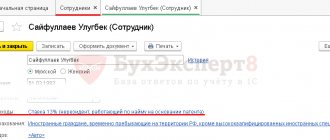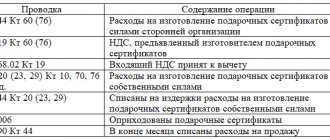- home
- Taxes
Evgeny Smirnov
Updated: April 7, 2020
0
Article navigation
- Important terms of the leasing agreement
- Is it possible to recover VAT on an advance payment?
- Accounting for VAT on advance payments in accounting entries
- Additional conditions for receiving a deduction
To provide themselves with guarantees regarding the reliability and solvency of the counterparty, lessors use a special form of prepayment - advance payments. The legislation does not set limits regarding their size, and the amount can be any, but more often - from 10 to 50%.
Lessees have the right to reduce VAT payments to the budget by the amount of tax they paid to the lessor as part of the advance payment. But in order to receive this deduction, taxpayers must take into account the specifics of the procedure in terms of documentation, and correctly draw up VAT entries for the advance payment.
The regulatory framework governing the accounting of VAT on advance payments for leasing: Chapter 21 of the Tax Code, Letter of the Ministry of Finance numbered 03-07-03/34 dated 03/19/07.
Important components of a leasing agreement
The leasing agreement is always drawn up in writing. It reflects all the terms of the transaction, including:
- Name of the parties involved.
- Detailed description of the leased item.
- Cost of the leasing agreement.
- The period of validity of the transaction.
- Procedure and terms for making payments.
- Conditions for the return or redemption of property into the client's ownership.
- The amount of the redemption price.
In addition, the leasing agreement specifies the amount of the advance payment (down payment), if the agreement is drawn up taking into account its payment.
The down payment performs several functions simultaneously. Payment of an advance is one of the confirmations of the borrower’s reliability and solvency. Additionally, such a contribution allows you to reduce the financial burden of further payments.
The larger the down payment, the smaller your monthly payments will be.
Main elements of a leasing agreement
The leasing agreement includes detailed conditions:
- The name of the two parties - the leasing organization and the lessee company.
- Detailed description of the property to be leased.
- The cost of leasing services and the term of the transaction.
- Monthly payment schedule.
- Conditions under which the property will be returned to the leasing company or purchased by the lessee.
A special clause in the contract sets out the amount of the advance payment if the transaction is concluded with an initial payment. This amount is important - it confirms the financial reliability of the lessee, and also significantly reduces the financial burden of monthly payments. The larger the advance amount, the smaller the regular leasing payments.
Advance payment under a leasing agreement
Payment under leasing transactions is used by the lender to ensure the fulfillment of all obligations by the lessee.
The amount of the down payment varies from 5 to 50%, depending on the requirements set by the leasing company.
The advance payment is made by the borrower immediately after execution of the contract. The down payment can be paid in one lump sum or in installments, as previously agreed upon by the parties involved. In the case of gradual payment, a schedule for offset of such payments is drawn up, which is displayed in the agreement itself or is provided in a separate application.
The advance payment can be credited in several ways:
- The full agreed amount when paying the first installment of the lease payment.
- One-time in the process of making the last part of the payment under the leasing agreement.
- In equal parts during the validity period of the transaction itself.
If the down payment is made in one payment, then the lender immediately after receiving it pays the full cost of the property to the seller. Next, the necessary documents are completed, after which the subject of the transaction is placed at the disposal of the borrower.
Drawing up a leasing agreement
The leasing agreement is drawn up in writing, reflecting the mandatory essential terms of the agreement :
- name of the lessor and lessee,
- detailed description of the leased property,
- leasing agreement price,
- period of validity of the contractual relationship,
- terms and procedure for making leasing payments,
- procedure for return or redemption of leased property, etc.
Together with the execution of the leasing agreement, a schedule for making advance and leasing payments is drawn up.
Important nuances of accounting for advance payments
An advance payment is provided for in most leasing agreements, and its offset can be made in any of the provided ways. For example, against the starting payment, against several starting payments until the advance amount is fully repaid, evenly during the repayment of the main debt, against the last payment under the leasing agreement, etc.
The lender, in the process of transferring the property to the lessor, provides an invoice for the entire amount of the advance payment. In this case, this amount, excluding VAT in tax reports, can be taken into account as expenses when taxing profits.
As part of leasing transactions, services are provided until the end of the agreement, so tax structures do not need to compare such payments with the norms of the Tax Code of the Russian Federation. And you don’t have to worry about how to reflect the down payment in the leasing company’s turnover.
As for the partial payment of the advance, borrowers often have a question about whether these payments can be immediately attributed to expenses. The answer will be negative, since in this case the amount of the down payment will be counted as an expense in accounting for income taxation. Similar conditions are met if the lessor accepted the advance payment not according to the current schedule.
Accounting Features
An advance is provided for in most leasing transactions. It can be credited in various ways:
- The full amount of the advance when paying the first payment for leasing;
- Evenly in monthly payments in the “body” of the principal debt;
- In the final payment on a leasing transaction.
In case of partial payment of the advance, the borrower cannot immediately attribute the advance payments to expenses, since the amount of the down payment will be considered an expense. The same conditions apply if the lessor accepts the advance payment not according to the agreed schedule.
Accounting for advance payments from the lessee
The down payment for a leasing transaction in the borrower's accounting (transfer and offset) is made in the agreed amount and the period for offset of the advance by the lender, as part of the amount of leasing payments. The transfer of the advance is recorded as follows: to the debit of account 76 to the subaccount of advances issued from the credit of account 51.
VAT on the advance payment under the leasing agreement is taken into account by the lessee as follows:
| Debit | Credit |
| 68 (VAT subaccount) | 76 |
The borrower records the amount of the advance as follows:
| Debit | Credit |
| 76 (sub-account of debt for leasing payments) | 76 (sub-account of advances issued) |
Advance payments are an important condition of any contract, including leasing agreements. Therefore, a detailed description and, in general, recording of its terms in the document will help to avoid controversial and unforeseen situations, including fraudulent actions.
Accounting for advance payment from the lessee
An advance payment under a leasing agreement in the lessee's accounting (transfer and offset) is made in the amount and terms of offset of the advance by the lessor, as part of the amount of leasing payments, which is prescribed in the terms of the leasing agreement . The transfer of the advance stipulated by the leasing agreement is recorded: in the debit of account 76 to the subaccount of advances issued from the credit of account 51.
The amount of VAT accepted for deduction from the advance payment is taken into account:
- D-t 68 accounts VAT sub-account - K-t 76 accounts.
the offset of the advance amount under the leasing agreement :
- D-t 76 accounts, sub-account for debt on leasing payments - K-t 76 accounts, sub-account for advances issued.
When drawing up a leasing agreement, it is necessary to take into account all the nuances of payment, redemption, and return of leased property. Advance payments are an essential condition of any contract and a detailed description of the timing, amount of payment and offset of the advance will protect you from unforeseen conflict situations . To document contractual relations, contact qualified lawyers.
Civil law basics
One of the forms of rental relations is leasing.
The subject of leasing can be any non-consumable things, except for land plots and other natural objects (Article 666 of the Civil Code of the Russian Federation).
According to Art. 607 of the Civil Code of the Russian Federation, non-consumable things are, for example, enterprises and other property complexes, buildings, structures, equipment, vehicles and other things that do not lose their natural properties during their use. In addition to the Civil Code of the Russian Federation, leasing relations are also regulated by Federal Law No. 164-FZ of October 29, 1998 “On financial rent (leasing)” (hereinafter referred to as Law No. 164-FZ).
Under a leasing agreement, the lessor undertakes to acquire ownership of certain property from a certain seller in order to transfer it for a fee for a certain period as a leased asset to the lessee (Article 2, paragraph 4 of Article 15 of the Federal Law of October 29, 1998 N 164-FZ “On Financial rent (leasing)”, Article 665 of the Civil Code of the Russian Federation).
The size, method of implementation and frequency of leasing payments are determined by the leasing agreement (clause 2 of article 28 of Federal Law N 164-FZ).
Property transferred for temporary possession and use to the lessee is the property of the lessor (Clause 1, Article 11 of Law No. 164-FZ). In this case, by mutual agreement of the parties, leased property can be recorded on the balance sheet of the lessee or on the balance sheet of the lessor (Clause 1, Article 31 of Law No. 164-FZ).
Upon expiration of the leasing agreement, the lessee may acquire ownership of the leased asset if this is provided for in the leasing agreement (Clause 5, Article 15 of Federal Law No. 164-FZ). In this case, the total amount of the leasing agreement may include the redemption price of the leased asset (Clause 1, Article 28 of Federal Law No. 164-FZ).
Accounting for leasing transactions must be carried out in accordance with Order of the Ministry of Finance of Russia dated February 17, 1997 N 15, which approved the Instructions on the reflection in accounting of transactions under a leasing agreement (hereinafter referred to as the Instructions).
Leased item on the lessee's balance sheet
Accounting
If, according to the terms of the agreement, the leased property is accounted for on the balance sheet of the lessee, then the lessee accounts for leasing transactions as follows.
Receipt of leased property
The cost of received leased property is reflected in the debit of account 08 “Investments in non-current assets”, subaccount “Purchase of individual fixed assets under a leasing agreement”, in correspondence with the credit of account 76 “Settlements with various debtors and creditors”, subaccount “Lease obligations”.
Then the costs associated with obtaining leased property and the cost of the object itself are written off from the credit of account 08 to the debit of account 01 “Fixed assets”, sub-account “Leased property” (paragraph 2, clause 8 of the Instructions).
From the provisions of clauses 4, 7, 8 PBU 6/01 and para. 2 clause 8 of the Instructions it follows that if the leased property is accounted for on the balance sheet of the lessee, then the leased item is accepted by the lessee for balance sheet accounting as part of fixed assets at its original cost, which is equal to the total amount of debt to the lessor under the leasing agreement excluding VAT.
Costs incurred by the lessee for delivery, bringing the leased asset to a state in which it is suitable for operation (including design, installation and commissioning work) are not subject to inclusion in the initial cost of the leased asset, accounted for under the financial lease (leasing) agreement on the balance sheet lessee (Resolution of the Federal Antimonopoly Service of the North-Western Territory dated November 19, 2010 in case No. A26-11541/2009, Resolution of the Supreme Arbitration Court of the Russian Federation dated April 12, 2011 No. VAS-251/11 refused to reconsider this case).
Leasing payments
The accrual of lease payments due to the lessor is reflected in the debit of account 76 “Settlements with various debtors and creditors”, sub-account “Lease obligations”, in correspondence with account 76 “Settlements with various debtors and creditors”, sub-account “Debt on leasing payments” (paragraph 2 clause 9 of the Instructions). That is, the amounts of lease payments due to the lessor from the lessee in this case are not recognized as an expense.
The essence of leasing
A leasing agreement is concluded between two interested parties. The subject of the contract is buildings, equipment, cars and other types of property. The lessee can become the legal owner of the leased property by purchasing it.
For the subject of leasing, you need to draw up a transfer and acceptance certificate. Depreciation is calculated by the party whose property is recorded on its balance sheet.
Fill out and send reports to the Federal Tax Service on time and without errors with Kontur.Extern. 3 months of service are free for you!
Try it
Accounting and tax accounting of leasing from the lessee
In order to correctly reflect the leased item on the accounting accounts, you need to know on whose balance sheet it is listed.
Accounting for leased property on the lessor's balance sheet
If the object is accounted for on the lessor's balance sheet, the lessee uses accounting account 001. It is from this account that all leasing operations begin. Using the example of Tekhnik LLC and Spusk LLC, we will analyze all the nuances of accounting. You will find not only postings, but also detailed calculations.
Tekhnik LLC received from Spusk LLC under agreement No. 25 dated January 1, 2019, a lease of the A187 hydroelectric power station worth 1,296,000 rubles, including VAT 216,000 rubles. The total rental period is 36 months. The monthly payment is 36,000 rubles, including VAT (20%) 6,000 rubles. After three years, the equipment is purchased by Tekhnik LLC, the redemption price is already included in the monthly payments.
In the accounting of Tekhnik LLC, the accountant will make the following entries under the leasing agreement:
Debit 001 - 1,296,000 - equipment is put on off-balance sheet accounting
Debit (20, 26, 44 - depending on the purposes for which the leased asset is used) Credit 76 - 30,000 - monthly lease payment accrued (the accountant of Tekhnik LLC will make this entry monthly for three years)
Debit 19 Credit 76 - 6,000 - VAT on the lease payment is reflected (Tekhnik LLC will make this entry once a month)
Debit 68 Credit 19 - 6,000 - VAT accepted for deduction (Tekhnik LLC will make this entry monthly)
Debit 76 Credit 51 - 36,000 - the lease payment was transferred to the account of Spusk LLC (Tekhnik LLC will make this posting monthly)
Loan 001 - 1,296,000 - equipment was written off from the register of Tekhnik LLC, since all obligations under agreement No. 25 dated 01/01/2019 were fulfilled
Debit 01 Credit 02 - 1,080,000 (1,296,000 - 216,000) - the cost of the purchased hydroelectric power station A187 is reflected in the fixed assets of Tekhnik LLC
Redemption value of leased property: transactions with the lessee
If Tekhnik LLC bought the equipment for a fee, the following entries would be made in accounting:
Credit 001 - equipment was written off from the register of Tekhnik LLC due to the expiration of contract No. 25 dated 01/01/2019
Debit 60 Credit 51 - redemption price for hydroelectric power station A187 is transferred
Debit 08 Credit 76 - leased equipment purchased (hydroelectric power station A187)
Debit 19 Credit 76 - VAT included
Debit 01 Credit 08 - the accountant of Tekhnik LLC included hydroelectric power station A187 in fixed assets
Debit 68 Credit 19 - VAT on hydroelectric power station A187 accepted for deduction
Early repurchase of leased property: postings from the lessee
Debit 97 Credit 76 - the amount of remaining lease payments excluding VAT
Debit 19 Credit 76 - VAT allocated
Debit 68 Credit 19 - VAT is accepted for deduction.
Debit 76 Credit 51 - the remaining lease payments are listed
Debit 20 Credit 97 - the accrued amount of payments is written off ahead of schedule (monthly for the remaining term under the agreement)
Accounting for leased property on the lessee's balance sheet: entries
Tekhnik LLC received from Spusk LLC under agreement No. 25 dated January 1, 2019, a lease of the A187 hydroelectric power station worth 1,296,000 rubles, including VAT 216,000 rubles. The total rental period is 36 months. The monthly payment is 36,000 rubles, including VAT of 6,000 rubles. After three years, the equipment is purchased by the lessee for 20,000 rubles.
In this case, Tekhnik LLC will need to open sub-accounts to account 76, for example:
- "Rental obligations";
- "Debt on leasing payments."
The following entries will be made in the accounting of Tekhnik LLC under the leasing agreement:
Debit 08 Credit 76 (sub-account “Rental obligations”) - 1,096,666.67 (1,296,000 + 20,000) / 1.20) - hydroelectric power station A187 accepted for accounting
Debit 19 Credit 76 (sub-account “Rental obligations”) - 219,333.33 - VAT allocated
Debit 01 Credit 08 - 1,096,666.67 - equipment classified as fixed assets for further accounting
Debit 76 Credit 51 - 36,000 - the lease payment was transferred to the account of Spusk LLC (Tekhnik LLC will make this entry monthly for three years)
Debit 76 (sub-account “Lease obligations”) Credit 76 (sub-account “Debt on leasing payments”) - 30,000 - monthly lease payment accrued (the accountant of Tekhnik LLC will make this entry monthly for three years)
Debit 68 Credit 19 - 6,000 - VAT accepted for deduction (Tekhnik LLC will make this entry monthly)
Debit 20 (26, 44 - depending on the purposes for which the leased asset is used) Credit 02 - 30,462.96 (1,096,666.67 / 36) - depreciation accrued (Tekhnik LLC will make this entry monthly)
Debit 76 (sub-account “Lease obligations”) Credit 76 (sub-account “Debt on leasing payments”) - 20,000 - the debt on the redemption value of the leased property is reflected (the accountant of Tekhnik LLC will make this entry monthly for three years)
Debit 76 Credit 51 - 20,000 - transferred to the account of Spusk LLC, redemption price
Debit 01 Credit 01 - 1,096,666.67 - hydroelectric power station A187 transferred to the category of own funds after three years
Debit 02 Credit 02 - 1,096,666.67 - depreciation reflected
Reflection of leasing transactions by the Lessee when accounting for property on the lessee’s balance sheet
Accounting
The initial cost of leased property in accounting is the sum of all payments under the leasing agreement (security payment, preliminary payments, leasing payments, redemption value).
The useful life is equal to the term of the contract.
The property purchased at the end of the contract term is accepted as a new fixed asset or inventory, depending on the value of the redemption value.
Table 1 - Typical entries for leasing transactions*
| Contents of operation | Debit | Credit |
| Accounting for leased property | ||
| Received property from the lessor | 08 | 76-L/AO |
| The total amount of VAT under the agreement is reflected | 19 | 76-L/AO |
| Leased property is included in the fixed assets | 01-L | 08 |
| Depreciation accrued on leased property | 20 (25,26,44) | 02-L |
| The cost of depreciated leased property was written off at the end of the contract | 02-L | 01-L |
| Property received at redemption price | 10 (08) | 76-L/V |
| The property was accepted for accounting at the redemption value | 01 | 08 |
| Accounting for security deposit | ||
| Security payment transferred | 76-L/A | 51 |
| VAT reflected on the security deposit | 19 | 76-L/A |
| Accepted for deduction of VAT from the security deposit | 68 | 19 |
| Security deposit credited | 76-L/TP | 76-L/A |
| Recovered VAT from advance payment | 76-L/TP | 68 |
| Accounting for leasing payments | ||
| Lease payment paid | 76-L/TP | 51 |
| Lease payment accrued | 76-L/AO | 76-L/TP |
| Accepted for deduction of VAT on leasing payment | 68 | 19 |
| Accounting for redemption value | ||
| Redemption price paid | 76-L/V | 51 |
| VAT is reflected on the redemption price | 19 | 76-L/V |
| Accepted for deduction of VAT from the redemption price | 68 | 19 |
| Property received at redemption price | 10 (08) | 76-L/V |
| The property was accepted for accounting at the redemption value | 01 | 08 |
Tax accounting
The initial cost of leased property in tax accounting is the price of its acquisition, which is specified in the leasing agreement (the cost of the leased asset).
The useful life is determined according to general rules (in accordance with OKOF). If the property belongs to the fourth to tenth depreciation groups, then accelerated depreciation can be charged with an increasing factor of up to 3 inclusive.
Leasing payments are included in other expenses on a monthly basis. In this case, the amount of such expense is determined as the difference between the accrued lease payment and accrued depreciation (for the current month). If the calculation results in a negative value, then the lease payment is not taken into account in expenses.
It is necessary to ensure that the total amount of expenses recognized by you does not exceed the total amount of payments provided for in the agreement. In case of such an excess, it is necessary to stop recognizing lease payments as expenses.
Important: the leasing company is exempt from the obligation to issue monthly certificates of services rendered, so you can accept expenses for accounting based on accrual schedules, offset of advance payments and received invoices.
The redemption value can be taken into account only after the expiration of the lease agreement and the transfer of ownership of the leased property to your organization. There are two options for attributing the redemption value to expenses:
- if it is less than or equal to 100,000 rubles. - one-time as material expenses;
- if it is more than 100,000 rubles. - as the cost of purchasing a new OS object. In this case, the asset is accepted for accounting; according to the general rules, its useful life is established and depreciation is calculated.
You can fully deduct VAT on lessor invoices in the periods in which they are received. In this case, the lessor issues two types of invoices: for advance payment and for sale.
The first type of invoice is issued for the security payment (if it is not credited as a lump sum in the month of payment) and the difference between the accrued and actually paid lease payment (if it is negative). At its discretion, the lessee may not accept such invoices for accounting. However, if you have deducted VAT on the basis of an advance invoice, this VAT will need to be restored in the period when the security payment is credited and the leasing payment is accrued.
Invoices for sales are issued by the lessor in accordance with the schedule for calculating lease payments and offsetting the advance payment. An invoice for the surrender value is issued at the end of the lease agreement. Such documents are accepted by the lessee in accordance with the general procedure.
Accounting with the lessor
Let's take a closer look at leasing in transactions with the lessor.
Spusk LLC leased hydroelectric power station A187 to Tekhnik LLC under agreement No. 25 dated January 1, 2019, with an initial cost of 1,296,000 rubles, including VAT of 216,000 rubles. The total rental period is 36 months. The monthly payment is 36,000 rubles, including VAT of 6,000 rubles. After three years, the equipment is purchased by the lessee for 20,000 rubles. The redemption price is included in the monthly payments of Tekhnik LLC.
Leasing: accounting features for legal entities
Currently, both individuals and legal entities can lease a car. But the obligation to record transactions with such a car in accounting and tax accounting arises only for legal entities.
At the same time, legal entities can take advantage of certain preferences that individuals do not have, in particular, reduce the tax base for profits on leasing payments and deduct VAT paid to the lessor. It is important to remember that these preferences are applicable under the general taxation system. The use of special modes by legal entities is characterized by its own nuances, for example:
- when applying the simplified tax system “income”, leasing expenses cannot be written off as a reduction in the tax base in the same way as other expenses for conducting business;
- when applying UTII, the calculation of tax payable is also carried out according to certain principles, which do not include the deduction from the tax base of the costs of payments under the leasing agreement.
Further in the material we will talk about accounting for car leasing from legal entities located on OSNO. We will not touch upon tax accounting issues, since there are some discrepancies in the professional literature and publications due to the fact that the legal issues of leasing accounting in the Russian Federation are not fully regulated.
The issues of distinguishing between accounting and tax entries are presented in detail in the articles:






